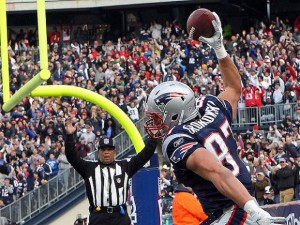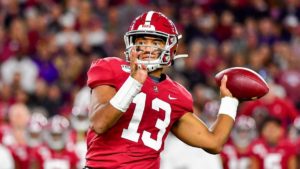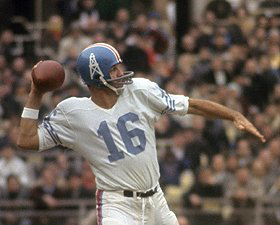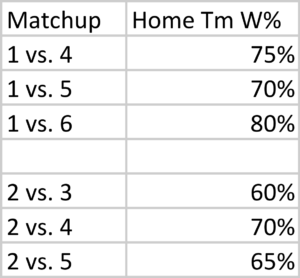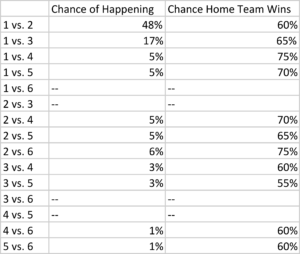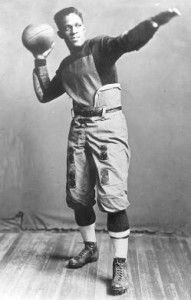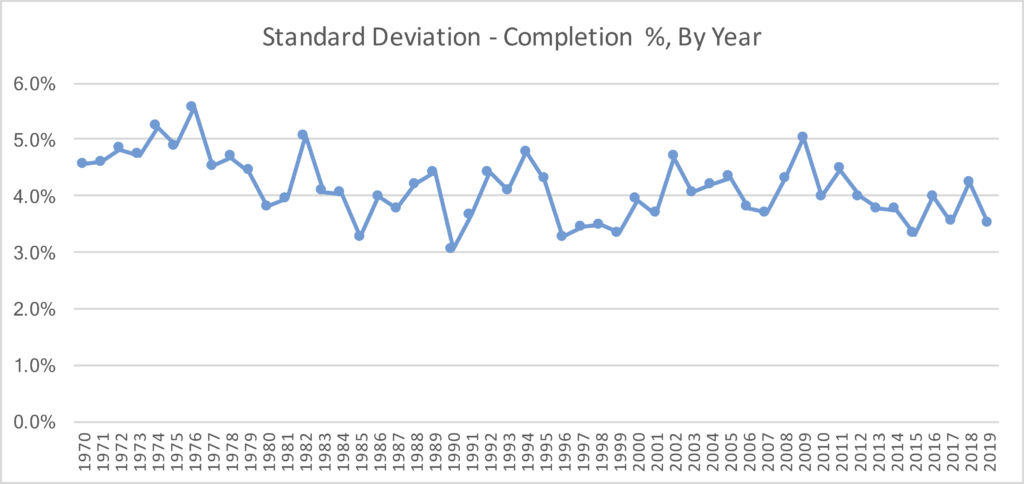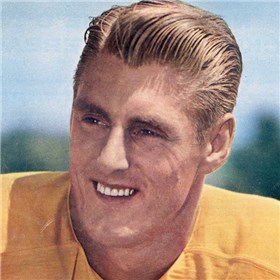This is the second installment of my Grand List, or: the top 1,000 pro football players in history. The section will cover players 989-965. I’m not particularly interested in writing a treatise on each player. If you are interested in that sort of thing, I highly recommend Brad Oremland‘s series on the 125 best players ever. I’m quarantined and starting to lose my mind, so you’ll be lucky to get a full paragraph for anyone. Send complaints to DeleteSansReading@gmail.com.
Previous articles in the series
The Grand List, part 1: Includes honorable/special mentions and players 1000-990.
Without further clamor…
The List, Continued
989. Hunk Anderson (1922-1925)
Offensive Guard, Defensive Line
Chicago Bears, Cleveland Indians
The brevity of his career keeps him from ranking higher on this list. Anderson played just four years, but his blocking was so dominant that he was still chosen for the Pro Football Hall of Fame’s all decade team. Hunk wasn’t that big, but he was strong and played with a level of aggression few could match. His most important trait was probably his mind. He had a deep repertoire of blocking techniques that served him well on the field and in his subsequent role as a celebrated assistant coach and champion head coach.
988. Bill Walsh (1949-1954)
Center
Pittsburgh Steelers
No, not that Bill Walsh. This is the standout Steel City center. His career was brief, but his play was consistently good and effective. Walsh was the pivot man in a single wing offense, meaning his role required complex blocking responsibilities and often physically demanding assignments. He handled them with aplomb and even filled in on defense when called upon.
987. Jack Manders (1933-1940)
Kicker, Running Back (pre-modern)
Chicago Bears
Automatic Jack was one of the premier kickers of his generation and was a solid halfback. He was an excellent big game player, scoring 11 of Chicago’s 23 points in a 1933 title win over the Giants, as well as two touchdowns in the team’s 1937 loss to Washington. Manders was a two time champion who led the league in scoring twice and ranked in the top 5 five times.
986. Sam Koch (2006-Present)
Punter
Baltimore Ravens
Whether bailing out a lackluster offense or gaining a little more field for a great offense, Koch has been stellar at his job. The 2014 season was probably his best, when he boasted a 43.3 net and a +22 inside 20-touchback differential, but he has had several great years. For his career, he has five times as many punts inside the 20 than he has touchbacks, giving him one of the top ratios ever. He also has maintained consistently high gross and net punting averages despite playing outdoors in a cold weather city. If you want a cherry on top of that sundae, Koch is also one of the better placekick holders the game has seen.
985. William Henderson (1995-2006)
Fullback
Green Bay Packers
A career Packer, Henderson embodied the Midwest understated,. hardworking mentality. He earned Pro Bowl/all pro honors just once, but he was just as good in less celebrated seasons. An excellent lead blocker, he led the way for Dorsey Levens and Ahman Green to post incredible rushing seasons. He also excelled in pass pro while blocking for the notoriously unpredictable Brett Favre. What sets him apart from other great blocking fullbacks is his ability to catch the ball out of the backfield.
984. Joe Guyon (1919-1927)
Running Back (pre-modern)
Canton Bulldogs, Oorang Indians, Cleveland Indians, New York Giants, Rock Island Independents, Kansas City Cowboys, Union Quakers of Philadelphia
A member of the Pro Football Hall of Fame, one of Guyon’s main claims to fame is that defenders who had to tackle both him and a past-his-prime Jim Thorpe credited the former with being harder to handle. Some said Thorpe brought the fans to the gates while Guyon made the plays. Usually lined up as a wingback, he was a tough as nails runner who was even better at delivering crushing blocks. He was also an excellent defender who was hard hitter and a playmaker, like an antediluvian Kenny Easley. Guyon started and ended on a high note, winning championships in his first and last years as a pro.
983. Al Mahrt (1913-1922)
Quarterback (pre-modern)
St. Mary’s Cadets/Dayton Gym-Cadets/Dayton Triangles
Mahrt was known by contemporaries as a gifted and natural tackler, capable of reeling in shifty runners in the open field or bringing down power backs head on. His hit on Joe Guyon in a 20-20 tie against Canton was the Bednarik-Gifford shot of its era. However, Mahrt’s primary accomplishment was his mastery of the forward pass. Writers described his arm as both strongest and most accurate of his day (or as accurate as you can be throwing around the old piece of cabbage they used to use). He was a three time champion player-coach prior to the NFL’s inception, and he earned one APFA all pro nod in the twilight of his career.
982. Rob Moore (1990-1999)
Wide Receivers
Arizona Cardinals, New York Jets
Moore’s inclusion on the list may come as a surprise, given the brevity of his true peak, but you’ll find as the list progresses that the good-but-not-great group of receivers to which he belongs is a large and tightly packed one. What sets him apart from some receivers with similar career numbers is the fact that he had one monster season (1997), in which he led the league with 1584 receiving yards and earned a first team all pro nod. He finished his career ranked 19th in receiving yards, but he has since fallen to 55th in the wake of the 21st Century Passing Explosion.
981. Bill Brown (1961-1974)
Running Back
Minnesota Vikings, Chicago Bears
Boom Boom Brown was a big, sturdy fullback who was especially adept at short yardage rushing and catching passes out of the backfield. He was a three-time all pro and a four-time Pro Bowler in his thirteen seasons in the Great White North. At the time of his retirement, Brown ranked 12th in both rushing yards and yards from scrimmage. His best season was a marvelous 1964 offensive that saw him pick up 866 yards on the ground and another 703 through the air (at an impressive 14.6 yards per reception), with 16 of Minnesota’s 37 offensive touchdowns.
980. Paul Lowe (1960-1969)
Running Back
Los Angeles/San Diego Chargers, Kansas City Chiefs
Lowe was the AFL’s second leading rusher, with 4995 yards, and was named to the Pro Football Hall of Fame’s All-AFL Team. He had a short and sweet career, with just five healthy seasons full of explosive, highlight reel type plays. Lowe was excellent in his first playoff game, gaining 165 yards and a touchdown on just 21 carries in a championship loss to the Oilers. He was also an exciting boom or bust passer on trick plays, completing less than half his passes but gaining 15.5 yards per attempt on 21 tries.
979. Wayne Millner (1936-1945)
End (pre-modern)
Boston/Washington
People who dive into the stats will often look at Millner’s receiving production and label him a bogus Hall of Fame selection. If you look at him solely as a receiver, then that makes sense (his 1937 championship performance notwithstanding). However, in an era when blocking was coveted, Millner was among the finest at the end position. He also happened to be superb defender. While not particularly large, he was strong. And fast – capable of chasing backs out wide or running down plays from behind. Two things hurt his legacy: WW2 and the Jerry Rice Problem. Millner missed three prime years in the Navy, and he missed out on postseason honors because he played the same position as a contemporary legend – Don Hutson.
978. Luke Johnsos (1929-1936)
End (pre-modern)
Chicago Bears
An accomplished coach after his playing career, the Professor used his natural understanding of the game to his advantage on the field. His smarts, combined with his height (6’2″ in an era that wasn’t common) and speed, made him a scary matchup for pre-modern secondaries. At one point, he was the official career leader in receptions and receiving yards. However, because his career began before the NFL kept official records, his achievements prior to 1932 are largely undocumented and unrecognized by the league he helped advance.
977. Red Badgro (1927-1936)
End (pre-modern)
New York Giants, New York Yankees, Brooklyn Dodgers
Athletically sound with a relentless motor, the New York legend was a four-time all pro and major player on squads that won one title game and lost another. In the loss, Badgro became the first player to score a touchdown in an NFL championship game, a 29 yard aerial with his fire-red mane blowing in the wild winds of Wrigley Field. His title win came when his 8-5 crew began a Giants tradition of upsetting great teams in the season’s final game – this time against the undefeated Chicago Bears. Like Millner, Badgro was an excellent blocker and a skilled defenseman.
976. Dick Bass (1960-1969)
Running Back
Los Angeles Rams
Bass wasn’t big but could block well, both as a lead and in pass pro. More importantly, he was a playmaker on both offense and special teams. While he made the first of his three Pro Bowls in 1962, his 1961 season was his most interesting. As a little-used runner, he had the longest run of the season. He also had the league’s longest punt return – an ill-advised 90 yarder that looked like a great idea in hindsight. Oh, Bass led the league in kickoff return average, too, and managed to do so without even scoring a touchdown. Along with halfback Jon Arnett, he was a small glimmer of hope in a dismal era of offense for the Rams.
975. Larry Centers (1990-2003)
Fullback
Arizona/Phoenix Cardinals, Washington, Buffalo Bills, New England Patriots
Centers excelled as a traditional “lineman in the backfield” fullback and could have potentially made this list for his blocking. He didn’t have the size of a Moose Johnston or Lorenzo Neal but was a technician who used leverage and angles to stop defenders at the second level. While his blocking was great, his best trait was his top flight receiving. He was the rare fullback who was also his team’s third down back, and his ability to protect the QB or catch the ball would make him a coveted back in today’s game. Centers finished his career with 6797 receiving yards, including 634 per season from 1993-2001.
974. Doak Walker (1950-1955)
Running Back, Defensive Back, Kicker
Detroit Lions
After becoming a college superstar, Walker graduated to the pros and literally did it all. He starred on offense and defense, he kicked and punted, and he returned kicks and punts. The golden boy played five healthy seasons and finished each of those years with a first team all pro selection. A guy who would be at home in a modern offense, Walker made the most of limited touches and put up big numbers as a receiving back. He led league in points scored in his first and last seasons.
973. Tony Richardson (1995-2010)
Fullback
Kansas City Chiefs, New York Jets, Minnesota Vikings
Richardson was on the small side for a blocking fullback, but he attacked linebackers play after play for 242 games. He made up for his relative lack of size with superior speed and agility compared to his peers. Early in his career, he had a few solid seasons as a runner and receiver, even posting a thousand yard season. He followed that by lead blocking for Priest Holmes in one of the greatest stretches of running back play in history, blocking for a rookie Adrian Peterson, and blocking for a run-heavy attack for the Jets.
972. Norb Sacksteder (1914-1925)
Running Back (pre-modern)
Dayton Triangles, Detroit Heralds, Detroit Tigers, Canton Bulldogs
A somewhat obscure name, Sacksteder was one of the first star offensive playmakers in pro football history. He was an excellent open field runner who combined top end speed with elite agility, like a precursor to Hugh McElhenny. Always a threat to score, historians estimate most of his touchdowns were longer than 50 yards. Though most of his accomplishments came before the NFL’s inaugural season, Sacksteder did play in the first-ever game between two NFL teams and was an excellent scatback for the 1922 champion Bulldogs.
971. Larry Craig (1939-1949)
Fullback (pre-modern)
Green Bay Packers
Craig was perhaps the finest blocking back of his era, clearing the way for names like Hinkle, Fritsch, and Canadeo. He only touched the ball 24 times on offense, and he actually scored more touchdowns on defense (one) than he did on offense (none). Powerfully composed, Craig did the dirty work in the Lambeau offense, swatting away hapless defenders like flies at a barbecue. His strength help make him a nightmare as a defensive end, able to put blockers on their heels seemingly at will. Craig’s play at end was a boon not just to the defensive line, but to the defense as a whole, as it meant moving Hutson to his more natural position as a defensive back.
970. Tony Canadeo (1941-1952)
Running Back (pre-modern)
Green Bay Packers
Canadeo was not much of a receiver, but he could run and pass well. He wasn’t that fast or that shifty, but he was sturdy and hard to tackle. This enabled him to excel in short yardage situations, as well as runs up the gut in general. As a passer, he had above average efficiency and was his team’s primary passer (and leading rusher) in 1943. That season, he trailed only legends Sid Luckman and Sammy Baugh in yards and touchdowns. Canadeo was also a solid defensive back who finished his career with 9 interceptions, as well as a contributor on special teams. He missed two years of his prime while serving in the Navy and the Army, which has to be taken into account when looking at his numbers and accolades.
969. Charley Trippi (1947-1955)
Running Back (pre-modern), Punter
Chicago Cardinals
Trippi was an explosive runner who put up consistently high rushing averages without breaking a ton of big plays. Instead, the three-time all pro just gained solid yardage seemingly every time he touched the football. Splitting carries in a committee backfield, he did post eye-popping totals, but he was always a headache for defenses when given the chance. He was a decent receiver early on before eschewing the role almost entirely. By his fifth season, began throwing the ball more than he caught it, though he wasn’t a very effective passer. Trippi was a decent punter and an excellent punt returner. With kickoff return duties as well, he led the league in all purpose yards in 1948 and 1949.
968. Father Lumpkin (1929-1937)
Fullback (pre-modern)
Portsmouth Spartans/Detroit Lions, Brooklyn Dodgers
Long before the pancake became part of the football vernacular, Father Lumpkin was putting grown men flat on their backs. At 6’2″ and 210 pounds, he was mighty figure in the early days of the league, barreling down on defenders with no helmet and a granite chin. As the designated lead blocker on most rushing plays, Lumpkin took his role seriously – he would bemoan any play that didn’t see him demolish multiple men at the second level. As a defensive fullback, he was an exceptional run defender who helped the Lions field one of the great defenses of any era in their first year in Detroit.
967. Whizzer White (1938-1941)
Running Back (pre-modern)
Detroit Lions, Pittsburgh Pirates
White would probably be in the Hall of Fame had he decided to stick to sports. Rather than continuing as a running back, he opted to move on to a role that matters: after receiving two Bronze Stars as an intelligence officer in the Navy during WW2, he finished his law degree from Yale on his way to becoming an associate justice for the SCOTUS. As a player, White was a shifty runner who led the NFL in rushing yards twice and punt return yardage once (the lone season he returned punts). He was also a decent punter and a pretty good defensive back.
966. Ward Cuff (1937-1947)
Kicker, Running Back (pre-modern)
New York Giants, Chicago Cardinals, Green Bay Packers
Statistics from the era are archaic, but from the numbers we do have, as well as from contemporary accounts, Cuff was the best kicker of his day. He was also a very good slashing runner, usually boasting a high rushing average and leading the league twice in the metric. Cuff was equally adept as a receiver, though playing in the thirties and forties hurt his opportunities to show off his pass catching talents. He was a very good defensive back with a nose for the football. In 1938, he returned an interception 96 yards for a score, and in 1941, he returned four picks for a league high 152 yards.
965. Michael Vick (2001-2015)
Quarterback
Atlanta Falcons, Philadelphia Eagles, New York Jets, Pittsburgh Steelers
A controversial selection, Vick was generally inaccurate as a passer, but he was capable of amazing plays with both arms and legs. Able to generate incredible torque and launch the ball with just a flick of his wrist, he could fit the ball into windows most quarterbacks wouldn’t even test. He is the fastest and most natural runner ever at the quarterback position. Vick missed two years of football because of his infamous role in a dogfighting ring, disappointing a fanbase and securing the eternal ire of many. He served his time and came back with a renewed love of the game, working under the tutelage of Andy Reid to produce his best season as a passer and earn a Bert Bell Award.

